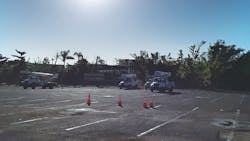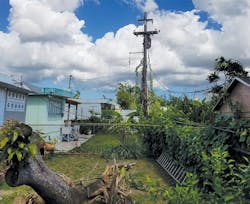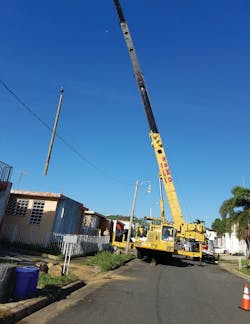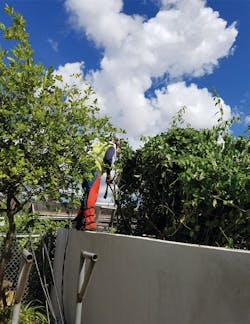Puerto Rico — "La Isla Del Encanto" or The Island of Enchantments — or as it is officially known: "The Commonwealth of Puerto Rico" is a beautiful tropical island in the middle of the Caribbean Sea, home to about 3.4 million people — all U.S. citizens. Ravaged by a deep, prolonged economic crisis, the island's political leaders had allowed a substantial decline in the standard of living, including a significant deterioration of the island's infrastructures. The aging electric transmission and distribution system had deteriorated as well, due in part to the substandard capital and maintenance investments.
Such a dire situation was exacerbated when on Sept. 7, 2017, Hurricane Irma carved a path of destruction through the northern part of the island, leaving about 1 million people in the dark. Irma's Category 5 super storm packed a 175-mph wind, making it one of the most powerful Atlantic Ocean hurricanes on record. Then, when the residents thought that they had seen the worst, on the morning of Sept. 20, Hurricane Maria, a Category 4 Storm, struck the island, devastating it and plunging the entire population into a desperate humanitarian crisis.
Hurricane Maria plowed across the island with sustained winds of 155 mph, downing electric and telecom facilities, uprooting big and small trees, and ripping zinc and wooden roofs off homes. The entire population was mainly left without electric power, potable water and other life-sustaining necessities.
Responding to a Call for Help
Many federal agencies, especially the Federal Emergency Management Agency (FEMA), and President Trump responded quickly to initiate rescue and emergency operations, and to restore some electric services. The governor of Puerto Rico requested mutual aid assistance as well. Responding to such a request, the governor of New York launched the "Empire 2 State Relief and Recovery Effort for Puerto Rico and the Virgin Islands" initiative.
Under this initiative, emergency construction crews from several major New York electric utility providers were enlisted. Both utility-owned and contractor crews were made available for this massive undertaking. Hundreds of crews were flown to the island, among them a contingent from Northline Utilities, LLC (NLU). On Nov. 18, I accompanied 35 NLU linemen on emergency duty to Puerto Rico, staying there for five weeks during November and December of 2017 and serving as the safety specialist.
After logistics and accommodations were taken care of, trucks, equipment and material were made available to the crews, initiating a major restoration effort. Since restoring service and fixing all damage in the San Juan Metropolitan area was a high priority, the NLU crews, other contractors and electric utility crews were assigned to work in this large, congested territory.
Identifying Hazards
Site-specific Emergency Health and Safety Plans (EHASP) plans were developed and discussed, along with a long list of hazardous conditions existing on the island. The restoration efforts were hindered during the first two weeks by the limited supply of potable water and ice and ongoing efforts to make required site drop-offs of the liquid and the bags of ice to hydrate the field crews. The intense daily heat, high ambient temperatures (in the 80s and 90s deg F) and the disorganized and dangerous street traffic conditions slowed down the progress.
Incident prevention was mandatory during the power restoration on the island. Detailed and meaningful job briefings were of paramount importance. Hazards and dangers were evident at any and every job site. Hazards included large piles of debris and vegetation placed next to utility poles and services, large grassy and uneven walking surfaces, packs of hungry stray dogs, dangerous tropical insects, reptiles and poisonous plants.
Effective mitigations were put in place to address all ubiquitous hazards — whether apparent or hidden. Some of the hazards included:
1. The weather and climate. From sunrise to sunset, sunshine and heat are the order of the day. Heat-related illnesses, skin burns, plain exhaustion — were always present. We tried to drink clean, bottled water, approved ice cubes in bags and Gatorade mix (50% water plus 50% Gatorade) drinks. Just drinking plain water while sweating could cause hyponatremia, a life-threatening electrolyte imbalance disorder caused by dilution of sodium in the blood. We also took short breaks in the shade, and we served as our brother’s and sister’s keepers. We took all precautions to prevent injuries and incidents. Because the crews also faced sporadic precipitation and flash floods; routine thunderstorms and lightning, they took refuge in indoor shelters or in the trucks. It was required for the crews to be first-aid/CPR-certified and have access to AED units in working order.
2. Cars everywhere. The first challenging and hazardous reality the crews experienced was the disorganized, heavy traffic. They traveled down narrow and winding roads with tree branches, palm leaves and debris everywhere. Many traffic lights at major intersections were not working, leading to the survival of the fittest. Pedestrians came and went with little regard for large trucks. Traffic cops sporadically worked — often on strike themselves due to union issues. Extreme caution was paramount.
3. The wire mess. Massive concrete, steel and wooden utility poles were down, as were wires. Primary, secondary/services and telecom cables were twisted on the ground. Pole hardware was spread around or in a pile along with nails, lags, broken ceramic insulators and crossarms. Broken wires were entangled on live conductors, which were all to be handled with great care while wearing all personal protective equipment (PPE) and ensuring downed conductors are deenergized.
4. Restoring the circuits. Multiple feeder lines (36 kV, 13 kV and 4 kV) were on the same poles. Transformers and equipment leads criss-crossed different feeders. Crews also encountered mismatched wye- and delta-configuration primary circuits as well as emergency generator backfeed. Lots of spacer cables were everywhere. “Expecting the unexpected” and “keen situation awareness” were the daily mottos.
Here were three unexplained, back-of-the-neck-hair-raising situations experienced:
a) Personal protective grounds installed on a circuit were disconnected and removed overnight by unknown persons.
b) Internal copper wiring from a large switch cabinet in a substation was stolen by unknown people. This just happened to be the same feeder our crews had repaired and waited for days to be turned on to pick up hundreds of services at a populated neighborhood.
c) A primary riser was cut at the base of the pole in the woods. This feeder was in the process of being turned on when the damage was found by the patrolling crew. The federal authorities investigated these incidents as possible sabotage.
5. Tropical insects and animals. Puerto Rico can be a "tropical paradise" in some places, but this includes, of course, tropical insects and animals. Since almost all the restoration work had to be done in rear-lot lines, the crews were exposed to many critters, broken glass, nails and other debris. They had to take care to not damage private property or backyard plants and flowers. Occasionally, the crews would come across fire ant mounds, snakes, sand fleas, spiders, scorpions, large centipedes, poisonous frogs and toads. But nothing rivaled the infamous mosquitoes. They were everywhere. Mosquito-borne diseases — such as Zika Virus, Dengue and Yellow Fever — had to be taken seriously. The crews wore long-sleeve shirts, work pants, safety glasses and safety shoes and pest-repellent applications. No tap water drinking was allowed. Above all, situational awareness was very important.
6. Topography and changing terrain. The island's topography is generally flat in the metropolitan areas; however, mountain ranges surround some of the large cities where the crews were working. Restoring services, fixing lines, and replacing broken poles and equipment were done along narrow, winding roads and paths, surrounded by heavy vegetation and breath-taking views. Sometimes, the work was done in landslide or mudslide-prone localities. After any precipitation, crews were on constant lookout.
7. Desperation and crime. The great majority of Puerto Ricans are law-abiding citizens. However, desperate people sometimes may be inclined to commit criminal offenses. In the Hurricane Maria aftermath, the police struggled to curb the crime wave, which existed at some level before the storm. FBI data shows the crime rate on the island to be at least at the pre-storm levels (according to an article written by David Ovalle of The Miami Herald, Oct. 20, 2017). Desperation emboldened criminals to prey on anyone venturing to walk around on streets cloaked in darkness. Burglary, robbery, mugging, assaults are common in small and large cities, especially along the Northern, South Central and West/Central West of the island. So, crew members were discouraged from traveling around, and told to never to go alone.
Despite the hazards and challenges faced on the island, the crews performed exceptionally. Their resolve and determination to "get the lights back on" and help others were unmatched. The crews experienced great satisfaction whenever the lines were repaired and services restored; and, their satisfaction was heightened by the sustained appreciation and good will from the Puerto Rican people, who had to endure outages for 100 days or more. An expression of hope and gratitude could be read on a banner attached to the wall of a building in San Juan: "Ayudando a Puerto Rico a Levantarse" (Helping Puerto Rico to Rise Up).
Editor's Note: For more coverage on hurricane recovery, see T&D World’s Disaster Response site at tdworld.com/disaster-response.
About the Author
Luis Ortega
Luis Ortega, CUSP, is a freelancer in occupational safety and related technical fields. For the last four years, he has worked as a safety specialist at Northline Utilities LLC, a T&D contractor in New York State. Ortega is proficient in OSHA, NESC, and other safety-related entities. He retired from Consolidated Edison Co. after a 30-year career. After 20 years of experience as a senior engineer in the Electrical Distribution Engineering Department at CoEd, he transferred over to the Overhead Construction Department to work as an operating line supervisor. At the end of his career, he worked as a quality assurance manager in the Electrical Ops. Organization. He holds a technical certificate from Power Technologies, Inc., and a bachelor of civil engineering from CCNY.






